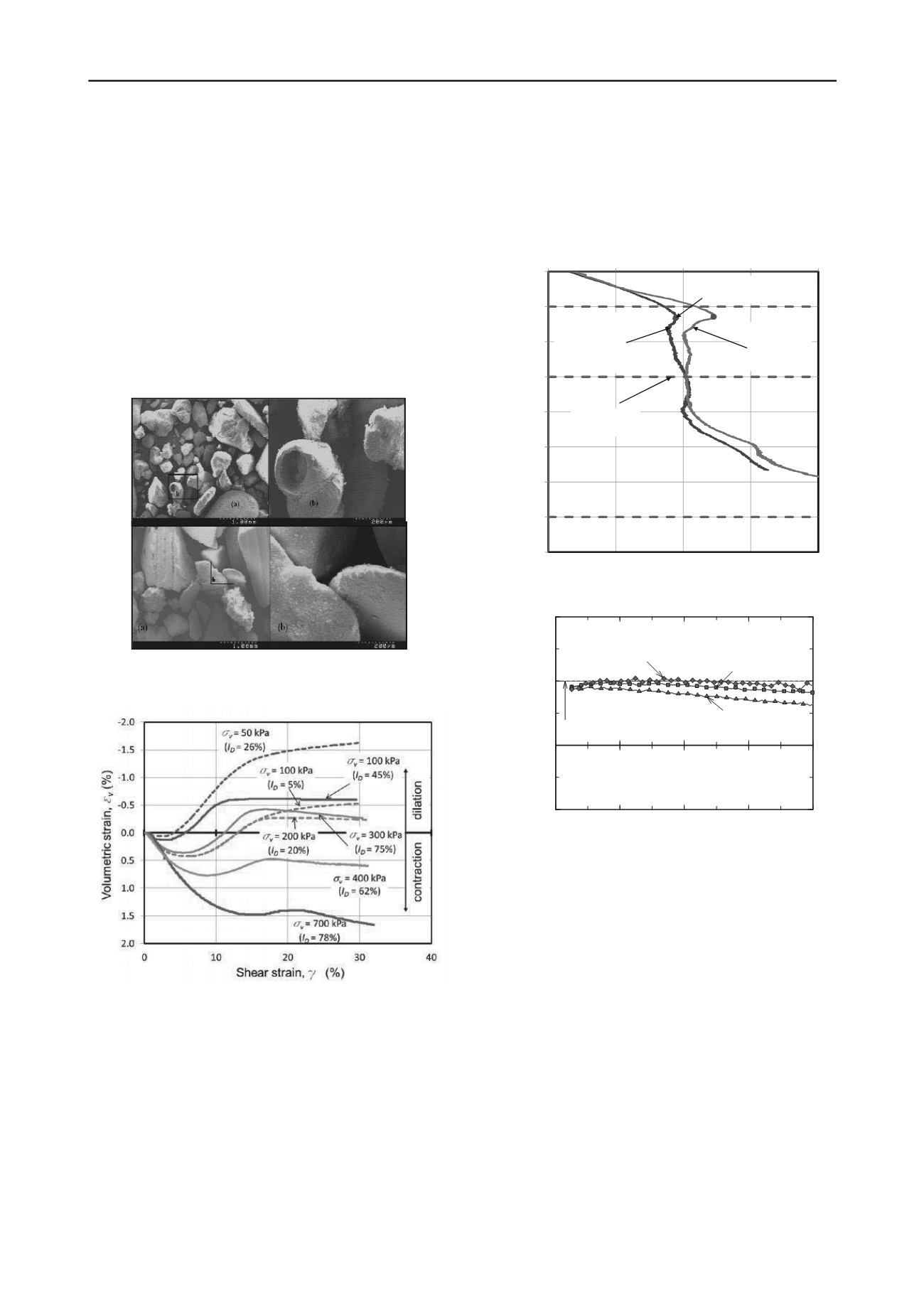
197
Technical Committee 101 - Session I /
Comité technique 101 - Session I
Proceedings of the 18
th
International Conference on Soil Mechanics and Geotechnical Engineering, Paris 2013
porosity, which result in high friction angles and
compressibility. The corresponding dilatancy is affected
strongly by the confining stress (Figure 17): even for low
relative densities, dilation occurs at low confining stresses,
reflecting the greater particle interlocking compared to silica
sand, while with the increase of confining stress, the dilatancy is
suppressed quickly, and finally diminishes completely at a
relatively low stress level, due to particle degradation. The
influence of the observed characteristics of carbonate and silica
sands on practical applications was examined through model
tests in drum centrifuge of spudcan foundations penetrating
through four-layer soils, with a carbonate or silica sand layer
interbedded in soft clay. All measures of spudcan punch-
through severity were significantly lower for interbedded
carbonate sand despite its higher friction angle (
crit
= 40
)
compared to silica sand (
crit
= 34
), Figure 18.
Figure 16. Microscopic images of Hormuz Island sand (top) and
Bushehr Port sand (bottom) from Shahnazari et al. (2013).
Figure 17. Volumetric change of carbonate sand in drained simple shear
test with lateral stress ratio
K
= 0.4 (Safinus et al. (2013).
Observations of the experimental behaviour of two pumice
sands from Japan and New Zealand are made by Kikkawa et al.
(2013). While the composition of Pumice sands is dominated by
silica and aluminium oxide, they are normally characterised by
the presence of particles that are easily crushed against a hard
surface under fingernail pressure. Considerable particle
breakage is occurring in triaxial compression loading, while
mobilization of the drained shear strength is increasing steadily
with the shear strain. However, owing to a different stress path,
less crushing is occurring in undrained testing. A particularly
interesting feature of the drained shear behaviour of these two
materials is that with a sufficiently large confining pressure they
tend to deform in one-dimensional compression way, with
practically no change in the diameter of the sample, also a
consequence of the large amount of particle crushing. An
example of observed incremental strain ratio evolution for one
of the materials during triaxial testing is shown in Figure 19.
0
0.25
0.5
0.75
1
1.25
1.5
1.75
2
0
100
200
300
400
Normalised penetration depth,
d
/
D
Vertical bearing pressure,
q
u
(kPa)
Soft clay
Soft clay
Carbonate
sand
I
D
= 38%;
f
crit
= 40
°
Silica sand
I
D
= 38%;
f
crit
= 34
°
Stiff clay
Punch-
through
Layer
interface
Figure 18. Effect of interbedded sand mineralogy on load penetration
response: severity of punch-through
(Safinus et al. (2013).
Figure 19. Incremental strain ratio against axial strain for drained
triaxial tests on pumice sand from Japan (Kikkawa et al. 2013).
6 CONCLUSION
This paper presents a General Report of 29 written
contributions from authors representing 22 countries submitted
for one of the parallel sessions,
Time effects and other peculiar
observation,
of the Technical Committee 101: Laboratory Stress
Strength Testing of Geomaterials. The General Report reviews
these contributions and presents the current research directions
mainly in relation to the experimental behaviour as well as the
key outcome results. The topics covered by the written
contributions have been grouped within the following thematic
strands:
Time effects: creep, strain rate effects in fine soils;
Consolidation/compressibility (loading and unloading);
Expansive soils: swelling/shrinkage characterisation;
Crushable granular soils.
Various analytical and constitutive modelling approaches
successfully assisted the interpretation of the presented
experimental data and in general, the research methodology
0
2
4
6
8
-1
0
1
2
Strain ratio
d
v
/
d
a
Axial strain
a
(%)
JPN pumice
d
=5.70kN/m
2
100kPa
JPN pumice
d
=5.77kN/m
2
1600kPa
JPN pumice
d
=5.70kN/m
2
400kPa
One dimensional
compression


